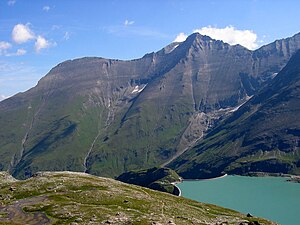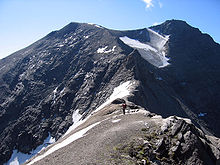High Tenn
| High Tenn | ||
|---|---|---|
|
West flank of the Hohe Tenn |
||
| height | 3368 m above sea level A. | |
| location | Salzburg , Austria | |
| Mountains | Glockner group | |
| Dominance | 2.1 km → Great Wiesbachhorn | |
| Notch height | 337 m ↓ Wiesbachschartl | |
| Coordinates | 47 ° 10 ′ 45 " N , 12 ° 45 ′ 2" E | |
|
|
||
| rock | Limestone mica schist / serpentinite summit structure | |
| First ascent | around 1840 by Cardinal Friedrich Prince Schwarzenberg in a small company | |
| Normal way | from the Gleiwitzer Hütte via Kempsenkopf, Hirzbachtörl and the northwest ridge to the summit | |
The Hohe Tenn , formerly also called Hochtenn , is a mountain in the Glockner group of the Hohe Tauern in the Austrian state of Salzburg . It has a south-west summit, called Bergspitze with a height of 3368 m above sea level. A. as well as a northeast peak, called Schneespitze , which is 3317 m above sea level. A. is high. The Tennsattel lies between the two peaks at an altitude of 3293 m .
The Hohe Tenn emits pronounced long ridges to the northeast and northwest. Particularly towards the north, it has a large geographical dominance , which, in conjunction with its easy accessibility, makes it a popular climbing mountain. Viewed from Zell am See im Pinzgau , it dominates the Tauern panorama behind the Imbachhorn ( 2470 m ).
history
According to unsecured information, the Hohe Tenn was first climbed in the 1840s by Cardinal Friedrich Prince Schwarzenberg in small company . The first literarily documented crossing of both peaks took place on August 16, 1871 by the fur trader Albert Kaindl from Linz and Josef Pöschl from Vienna with the mountain guide Johann Grill , known as the Kederbacher . However, the group already found trigonometric symbols on both peaks , which must have been brought up as part of the national survey in the 1850s.
Surroundings
From a geographical point of view, the Hohe Tenn lies in the center of the so-called Fuscher / Kapruner Kamm , which extends in a north-south direction. To the north the Tenn falls down into the Salzach Valley , to the east into the Fuscher Valley and to the west down to the Wasserfallboden reservoir in the Kaprun Valley . On the Hohen Tenn, west of the Tennsattel, in the summit area, is the so-called triangular firn field . Smaller glaciers are the Walcher Kees in the south-east, the Wielingerkees in the south-west and the small Hirzbachkees in the north-west . Neighboring significant peaks are just south of the Tenn. In the course of the ridge, separated by the Wiesbachschartl ( 3031 m ), the Kleine Wiesbachhorn with a height of 3283 m and, as the highest mountain in the area, the 3564 m high Große Wiesbachhorn . To the north is the insignificant Kleine Tenn ( 3158 m ). Fusch an der Großglocknerstrasse is about seven kilometers as the crow flies northeast of the Hohe Tenn and Kaprun a good 11 km north.
Base and routes
The path of Cardinal Schwarzenberg led from Fusch in the north-east over the Schmalzgrubenalm and the former Schmalzgrubenkees up to the Zwingkopf (3117 m) and then over the Tenngrat , the north-east ridge , to the summit. According to the literature, the walking time was about six hours.
Today the Gleiwitzer Hut at 2174 m serves as a base for an ascent of the Hohe Tenn . The normal route leads from the hut on the Gleiwitzer Höhenweg to the Kempsenkopf ( 3090 m ) and over the Bauernbrachkopf ( 3125 m ) down to the Hirzbachtörl . In the further course, the path leads very exposed along wire ropes and on iron pins up to the Kleine Tenn ( 3158 m ), finally over the northwest ridge to the summit. The climbing tour requires a head for heights and the ability to climb in UIAA difficulty levels II to III . According to the literature, the walking time is about 5 hours with a difference of 915 meters in altitude . Other climbing routes up to UIAA grade III lead through the north face and over the north pillar .
Literature and map
- Willi End : Alpine Club Guide Glockner Group , Bergverlag Rother , Munich 2003, ISBN 3-7633-1266-8
- Eduard Richter : The development of the Eastern Alps, III. Volume published by the German and Austrian Alpine Club, Berlin 1894
- Alpine Club map 1: 25,000, sheet 40, Glockner group
Individual evidence
- ↑ Clem Clements, Jonathan de Ferranti, Eberhard Jurgalski , Mark Trengove: The 3000 m SUMMITS of AUSTRIA - 242 peaks with at least 150 m of prominence , October 2011, p. 17.
- ↑ Federal Office for Metrology and Surveying Austria: Hoher Tenn on the Austrian Map online (Austrian map 1: 50,000) .
- ↑ Federal Office for Metrology and Surveying Austria: Snow peak on the Austrian Map online (Austrian map 1: 50,000) .
- ^ Willi End: Alpenvereinsführer Glocknergruppe , Munich 2003, p. 457
- ^ Journal of the German and Austrian Alpine Club , Volume II, Munich 1871, p. 274
- ^ Yearbook of the Austrian Alpine Club , IX. Volume, Vienna 1873, p. 166
- ↑ Willi End: Alpenvereinsführer Glocknergruppe , Munich 2003, pp. 458 ff., Margin no. 1641 ff.


